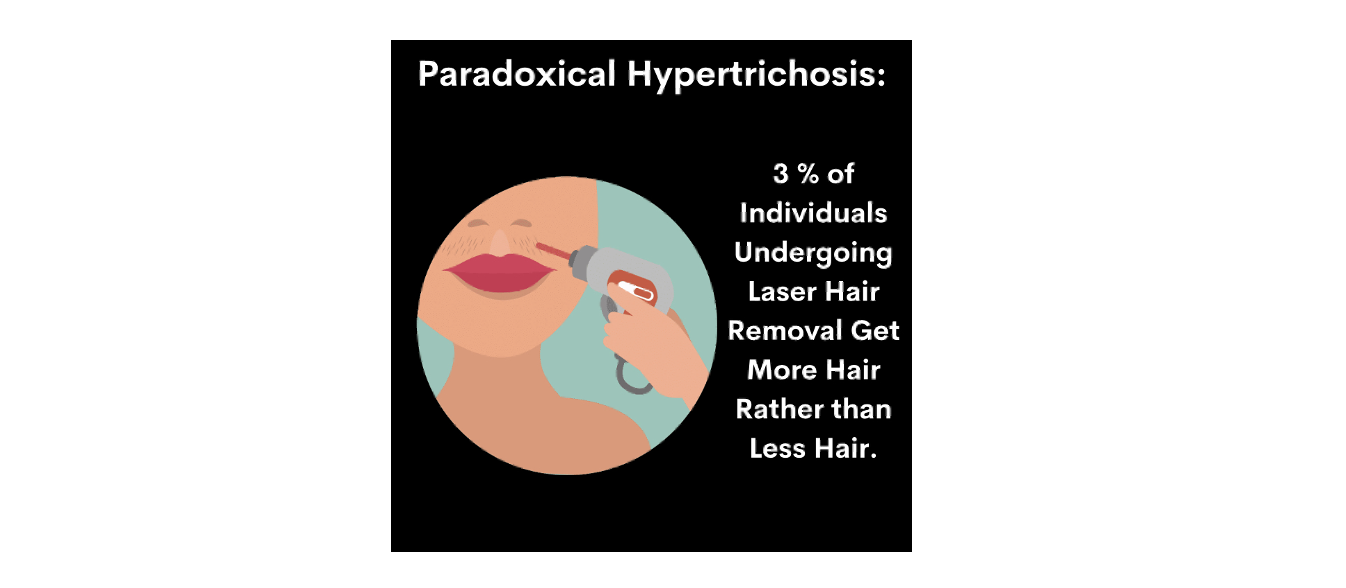Paradoxical Hypertrichosis. How common is it?
Paradoxical hypertrichosis estimated to occur in 3 % of those undergoing laser hair removal
Laser hair removal is one of the most frequently performed cosmetic procedures Different lasers (ruby, Alexandrite, Nd-YAG) and intense pulsed light (IPL) systems have been used for hair removal. The lasers target melanin in the hair follicle and cause selective thermolysis and this leads to hair removal.
On rare occasions, laser or IPL treatment leads to more hair in the area rather than less hair. This unwanted side effect is called “paradoxical hypertrichosis” or PH. In general, paradoxical hypertrichosis (PH) is an uncommon, poorly understood adverse effect associated with laser or intense pulsed light treatment for hair removal.
Snast et al, 2021
Authors from Israel set out to conduct a systematic review and meta-analysis to determine PH prevalence and associated risk factors. The included in their meta-analysis 9733 patients and this included 22 studies (2 randomized studies and 20 cohort studies)
Lasers Used
Alexandrite laser was evaluated in 13 studies, Intense pulsed light (IPL) in ten studies, and diode (800 and 810 nm) in 3 studies and neodymium-doped yttrium aluminum garnet lasers in 3 studies. The earliest study was published in 2002 by Moreno-Arias et al.and investigated the use of the IPL for facial hirsutism. The largest study was performed by Radmanesh et al. in 2008 and included 2541 patients.
Sites of Hair Removal
The face/neck was the most common (56%) treatment site, followed by the axillae (11%), groin (9%), limbs (6%), and torso (6%); For 11% of patients, the treatment site was not given.
Skin Type
In 19/22 studies, the III–IV skin type category was the most common, while in two studies, the I–II skin type category was the most common and the skin type was not reported in one study.
Treatment Interval
Treatment intervals ranged between 28 and 90 days.
Results of Meta-Analysis
The authors estimated that paradoxical hypertrichosis was found in 3% of patients. The phenomenon was associated mainly with a face or neck anatomic location, and occurred in only 0.08% of non-facial/neck cases. Treatment modality and interval between treatments was not found to have an effect on the rate of paradoxical hypertrichosis. The phenomenon of paradoxical hypertrichosis gradually improved with continued therapy in three of four studies.
This is a helpful study. Paradoxical hypertrichosis is not felt to be something that would be all that common on other areas besides the face and neck. Although very distressing, the authors point out that continuing treatment may be the best option. This, of course, needs to be taken on a case by case basis.
REFERENCE
Snast I et al. Paradoxical Hypertrichosis Associated with Laser and Light Therapy for Hair Removal: A Systematic Review and Meta-analysis Am J Clin Dermatol 2021 Sep;22(5):615-624
This article was written by Dr. Jeff Donovan, a Canadian and US board certified dermatologist specializing exclusively in hair loss.

